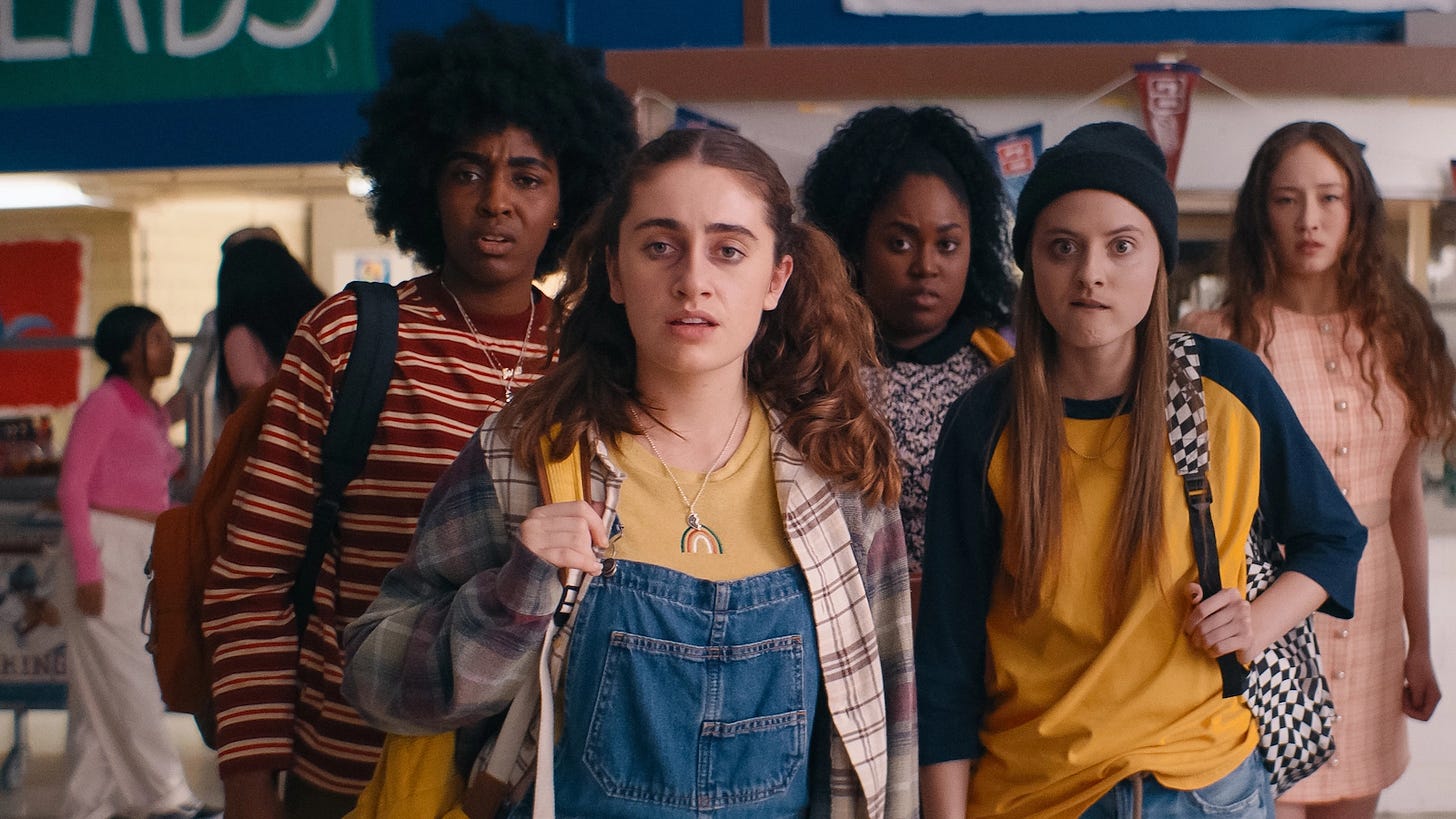In Review: 'Bottoms,' 'The Elephant 6 Recording Co.'
Emma Seligman and Rachel Sennott follow up 'Shiva Baby' with a rambunctious comedy and a documentary explores a thrilling moment in retro-psychedelic indie pop.
Bottoms
Dir. Emma Seligman
88 min.
Rachel Sennott is a force of nature, a chaos agent, a “human tornado” if Rudy Ray Moore hadn’t taken the title. After cutting her teeth in the alt-comedy scene—her “Puke Fest” shows, with Moss Perricone, combined stand-up with drinking games—Sennott landed the lead role in Emma Seligman’s superb indie debut Shiva Baby, playing a bisexual Jew whose romantic worlds collide at a shiva she attends with her parents. Shiva Baby is a panic attack of a comedy, but Seligman plays it like a 21st century screwball heroine, scrambling to keep multiple plates spinning while each one, in time, shatters on the floor. It’s a masterfully constructed film, with a forward-thinking attitude about sexual fluidity, but Sennott is the engine that keeps it revving.
Fresh off another irrepressible turn in Bodies, Bodies, Bodies, Sennott reunites with Seligman for their rambunctious follow-up film, Bottoms, but here she collaborates on the script, too. For better or worse—mostly better—Sennott’s voice is more imposing this time and the structure far more loosey-goosey, as if this raunchy high-school comedy was actually penned by teenagers whose hormones are running out of control. Just as there seem to be no rules governing Rock Ridge High, which resembles the classrooms at Vince Lombardi High School after The Ramones come to town, the film feels like it’s been improvised on the fly. It’s like telling a skilled improv group “teenage lesbian Fight Club” and watching them go.
Perhaps in an homage to P.J. Soles, that Ramones-loving spitfire in Rock ’n’ Roll High School, Sennett stars as PJ, a senior who’s determined to hook up with a good-looking girl before graduation. She and her partner in sapphic lust, Josie (Ayo Edebiri), strike out embarrassingly in their initial attempts to woo cheerleaders and other hot/popular girls, so they come up with the ridiculous idea to start a “Fight Club” in the name of self-defense and empowerment. The hope is to get physical with potential mates, but in practice, the club starts to take on a surprising life of its own. Much like in David Fincher’s Fight Club, the ritual of beating the hell out of each other turns out to be an excellent bonding experience, and even a bit of a cult. PJ and Josie just have to keep a lid on their motives.
In the grand tradition of adolescent romps where the teenagers are closer to 30 than 18—rest assured, no tutors or parents were lurking on the set—Bottoms gleefully disposes of any connection Rock Ridge might have to a real school. The football players, for one, wear their full uniforms wherever they go; in a particularly funny throwaway bit, a practice climaxes with the quarterback spiking the ball and doing an end zone celebration in the middle of the field. It doesn’t matter to Seligman and Sennott that PJ, Josie and company cannot pass for real kids; what matters is how their raw desire plays out in this sexually ambiguous arena. Like Shiva Baby, Bottoms seems like a snapshot of Gen-Z horniness, which doesn’t conform as much to straight-or-gay dichotomies. It’s something to sort out.
Perhaps inevitably, Bottoms comes off as sloppy and uneven at times, a victim of its own overweening gusto. It needs some of the discipline that Seligman brought to Shiva Baby. But as with her previous film, it benefits from limboing under 90 minutes and an insistence on moving things along quickly. It also has some lively supporting performances, especially former NFL running back Marshawn Lynch as Mr. G, the club’s faculty adviser, who’s just apathetic and divorced enough to allow it to happen. He’s like a stand-in for the audience itself: Gawping at how unhinged the action is before finally sanctioning this madness. — Scott Tobias
Bottoms opens in select theaters this weekend.
The Elephant 6 Recording Co.
Dir. C.B. Stockfleth
93 min.
In attempting to explain his musical aesthetic in this new documentary about the short-lived but rich and influential Elephant 6 music scene, producer and musician Robert Schneider points to a narrow slice of music history. “My ear needed to hear something on the quality of 1966, 1967. And nothing more slick than that,” he explains. “1969 would have been too slick.” It’s an apt summation of what drew together the many acts associated with Elephant 6. United by a love of psychedelia and classic pop songs and a strong preference for lo-fi, analog creativity, their work collectively sounds like an attempt to stretch a mid-’60s musical moment out to infinity, exploring possibilities others missed the first time around. With a nucleus rooted in childhood friendships, Elephant 6 gathered like-minded musicians and artists who freely traded ideas, played on each others’ records, and participated in visual art and film projects. It disintegrated despite these utopian ideals, but left behind a legacy of innovative, sometimes transcendent music, and an example for others to follow.
C.B. Stokfleth’s brisk, fond The Elephant 6 Recording Co. pretty much admits from its opening credits—which name a few core acts, then groups everyone else under the heading “and several more”—that it can’t tell the full, sprawling Elephant 6 story, with its complicated timeline and dozens of acts. But the film neatly sums up where Elephant 6 came from and what it meant. The movement had its roots in the unlikely musical hotbed of Ruston, Louisiana, a college town in the north of the state. It’s the place where musical misfits inevitably found one another, including childhood friends Schneider (later to head The Apples in Stereo and produce many other acts), Bill Doss and Will Hart (the core members of Olivia Tremor Control) and Jeff Mangum (of Neutral Milk Hotel). After going their separate ways, they effectively started Elephant 6 branches in Denver, Colorado and Athens, Georgia where others, like Elf Power, came into the fold. Made with little money and no industry interest but a lot of restless energy, their thrift store vision of American pop slowly built a widespread cult following over the course of the 1990s.
Stockfleth offers a satisfying survey of the movement via new interviews and a generous selection of archival performance footage, though the breadth sometimes comes at the expense of depth. Splits, disagreements, and disappointments get alluded to, as do Mangum’s personal struggles, but the details remain vague. (Present only via archival footage and interviews, Mangum did not participate, but the film seems to have secured virtually every other surviving Elephant 6 member.) There’s little space given to what separates one band from another and who played what and when, but in a way that’s appropriate. Elephant 6 was born of a communal vision and, as famous fans Elijah Wood and David Cross both attest, a certain amount of confusion is baked into the experience. The enigma of how a handful of musicians who emerged from nowhere could create a pocket-sized pop universe was always central to its appeal. —Keith Phipps
The Elephant 6 Recording Co. opens in limited release tomorrow.









Elephant 6 is one of the few musical movements I can claim to be on the ground floor in experiencing. I spent a few years as a townie in Athens in the mid-'90s after graduating from UGA and I have a very strong memory of Henry Owings, Chunklet publisher and frequenter of Video Library, passing along a cassette dub of Olivia Tremor Control's "Dusk at Cubist's Castle," which of course blew my mind. I remember seeing OTC at the Shoebox, which was the tiny venue next to the more famous 40 Watt, and wound up seeing most of the major Elephant 6 outfits thereafter. Good times...
Forgot to mention that friend of The Reveal Jason Heller is interviewed in Elephant 6.